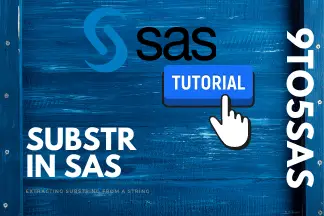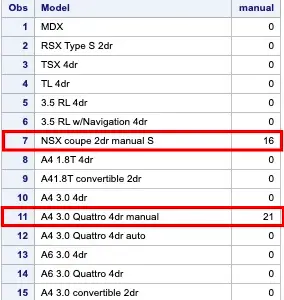The SUBSTR in SAS is used to extract part of a string. But apart from extracting parts of a string, it has another important use.SUBSTR function can be used on the left side of the assignment statement and also on the right side.
SAS Substr from right
The SUBSTR function returns a portion of a string that you specify in the string. The part begins with the character you specify in the start-position argument and the number of characters you specify in length.
If the length of the returned variable is not defined, it is assigned with the length of the first argument.
Syntax
SUBSTR(character-value,start-position,number-of-characters-to-read)
- character-value is any SAS character expression.
- start-position is the starting position within the string.
- number-of-characters-to-read is the length argument to read from the start position to the given length, and if it is not specified, it reads the number of characters from the start position to the end of the string.
Note: The length of the resulting variable will be the length of the character value if the length is not previously assigned.
| Examples | Results |
|---|---|
| SUBSTR(“ABC123XYZ”,4,2) | 12 |
| SUBSTR(“ABC123XYZ”,4) | 123XYZ |
SAS Substr on left
When you use the SUBSTR function on the left side of the equal sign, SAS replaces the variable’s value with the expression on the right side. SUBSTR replaces length characters, starting with the character you specify in the position argument (2nd Argument).
If you use an undeclared variable, it is assigned a default length of 8.
Syntax:
SUBSTR(character-value,start,) = charcter-value
- Character-value is any SAS character expression.
- The start is the starting position in a string where you want to place the length of the new character.
- Length is the number of characters to be placed in that string. If length is omitted all the characters on the right-hand side of the equal sign replaces the characters in the character value.
| Examples | Results |
|---|---|
| SUBSTR(“Pin Code 411014”, 4, 5) = “:”; | “Pin Code 411014” |
| SUBSTR(“Pin Code 411014”,4) | Pin: |
SUBSTR in SAS on Left-Side and the colon modifier
The use of SUBSTR on the left-hand side is similar to the use of the SAS COLON MODIFIER ( =: ).
Both methods allow the comparison of values based on the prefix of a text string.
The advantage of using SUBSTR over the COLON MODIFIER is that SUBSTR can also be used in MACRO statements.
Example:
data test;
length name $20 president $4;
name = 'GEORGE WASHINGTON';
president = 'YES' ;
output;
name = 'THOMAS JEFFERSON' ;
president = 'yes' ;
output;
name = 'BENJAMIN FRANKLIN';
president = 'Nope';
output;
run;Example Data
name president GEORGE WASHINGTON YES YESTHOMAS JEFFERSON yes BENJAMIN FRANKLIN Nope
Observe the variable president in the sample data contains ‘Yes’ and ‘No’ values. The code below turns this inconsistent data into a useful text message.
data test1;
set test;
if upcase(president)=: 'N' then
text_msg=name || 'Was not President of the USA';
if upcase(substr(president, 1, 1))='Y' then
text_msg=name || 'Was President of the USA';
run;Output:

How to extract the last n characters SAS?
The SUBSTR function’s second and third arguments must be positive. But what if we needed to specify the position (second argument) that will start extracting input relative to the end rather than the beginning of the string?
There are two ways you can achieve this.
Method 1: Using a combination of LENGTH and the SUBSTR function.
We will use the substr function to extract the last three characters from the string
data fileext;
fname = "data.csv";
ext=substr(fname,length(fname)-2,3);
run;| fname | ext |
| data.csv | csv |
The length function is used to find the starting position of the input string.
Similarly, if we have to find the last four characters, adjust the length function as below.
ext=substr(fname,length(fname)-3,4);
Method 2: Using REVERSE and SUBSTR Function
Another way of achieving this is to reverse the string so that the first character becomes the last.
Then, apply the SUBSTR function to extract the first three characters and reverse the SUBSTR function’s result again.
data fileext;
fname = "data.csv";
reverse_fname = reverse(fname);
first_three=substr(reverse_fname,1,3);
reverse_first_three=reverse(first_three);
run;| fname | reverse_fname | first_three | reverse_first_three |
| data.csv | vsc.atad | vsc | csv |
All three steps can be combined in a single step as below.
ext=reverse(substr(reverse(fname),1,3));
SUBSTRN Function
This function serves the same purpose as the SUBSTR function with a few additional features. The starting position and the length arguments of the SUBSTRN function can be 0 or negative without causing an error.
Syntax:
SUBSTRN(character-value,start,)
Difference between SUBSTR and SUBSTRN
The SUBSTR in SAS is one of the frequently used character functions for extracting substring from a string, but it can be frustrating when it issues an abrupt NOTE to the log when the start or length argument is more than the length of the string.
Preparing the Test data
data _null_;
String1='Hello World';
a=substr(string1, 1, 5);
b=substr(string1, 1, 15);
c=substr(string1, 15, 10);
put a=b=c=;
run;SAS LOG
NOTE: Invalid third argument to function SUBSTR at line 74 column 5. NOTE: Invalid second argument to function SUBSTR at line 75 column 5. a=Hello b=Hello World c= String1=Hello World a=Hello b=Hello World c= _ERROR_=1 _N_=1
If the design of your code can allow a null result from the sub-string function, consider using SUBSTRN.
This function provides the same essential functionality as SUBSTR but will not issue a NOTE message if it returns a null result.
The example below shows the use of the SUBSTRN function.
data _null_;
String1='Hello World';
a=substrn(string1, 1, 5);
b=substrn(string1, 1, 15);
c=substrn(string1, 15, 10);
put a=b=c=;
run;OUTPUT
a=Hello b=Hello World c=
SUBPAD Function
SUBPAD function returns a substring of the length specified in the argument with blank padding.
If either position or length has a missing value, SUBPAD returns a string with zero length.
If the position is negative, the result is padded with 1-position leading blanks.
If the specified substring extends beyond the end of the string, the result is padded with trailing blanks.
In a WHERE statement or the SQL procedure, the length of the value returned by the SUBPAD function cannot exceed 200.
Syntax:
SUBPAD(string, position,)
Example
data _NULL_;
string="Hello World";
a='*'|| subpad(string, -1, 0) || '*';
b='*'|| subpad(string, 1, 0) || '*';
c='*'|| subpad(string, 1, 20) || '*';
d='*'|| subpad(string, -1, 7) || '*';
put a=b=c=d=;
run;OUTPUT
a=** b=** c=*Hello World * d=* Hello*
Difference between SUBPAD and SUBSTR
The SUBPAD function is similar to the SUBSTR function except for the following differences:
- If the position argument is 0 or negative, SUBPAD adds leading blanks to the result, whereas SUBSTR writes a note -the second argument is invalid, sets automatic variable ERROR=1.
- If the length argument is zero, SUBPAD returns a zero-length string, whereas SUBSTR prints a note – Third argument is invalid and sets ERROR=1.
- If the specified substring extends the end of the string, SUBPAD pads the result with blanks to match the requested length, whereas SUBSTR prints a note – The third argument is invalid and sets ERROR=1.
CHAR Function
The CHAR function returns a single character from a specified position in a character string.
Syntax
CHAR(string, position)
| Examples | Results |
|---|---|
| char(“Hello World”,0); | |
| char(“Hello World”,1); | H |
| char(“Hello World”,7); | W |
| char(“Hello World”,20); |
FIRST Function
The FIRST function returns the first character in a given string having a length of 1. It returns a single blank if the length of the string is 0.
Syntax
<strong>FIRST</strong>(string)
| Examples | Results |
|---|---|
| first(“Hello World”) | H |
| first(“”) |
Key Takeaway
So, these are the different SAS character functions to extract a substring from a string.
SUBSTR and SUBSTRN have more flexibility than the others. Use the SUBSTRN function when you can have null values in the result.
Use the FIRST function if you need to extract only the first character of the substring, and use the CHAR function to extract only one character from any position of the string.
Moreover, if you have any other suggestions regarding other tips or tricks to add, suggest us below the comment section. We will take those lists in our further blog post.
Thanks for reading!
If you liked this article, you might also want to read SAS Numeric functions and Operators.
Do you have any tips to add? Let us know in the comments.
Please subscribe to our mailing list for weekly updates. You can also find us on Instagram and Facebook.





